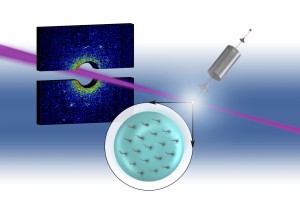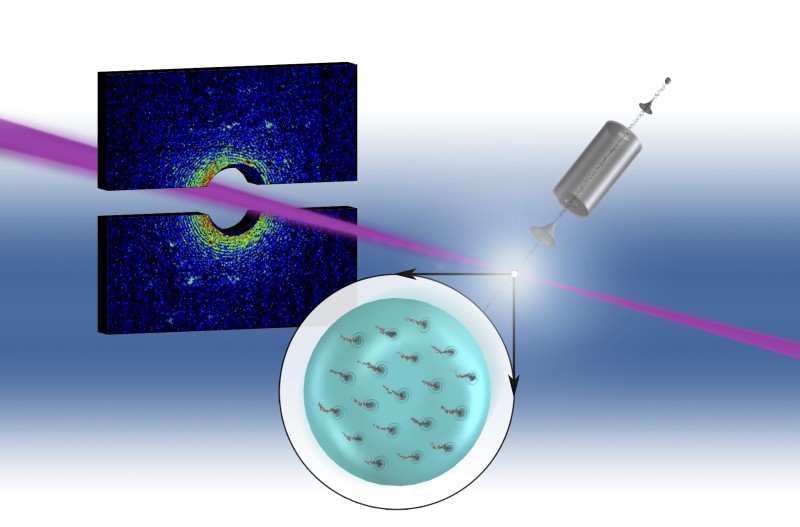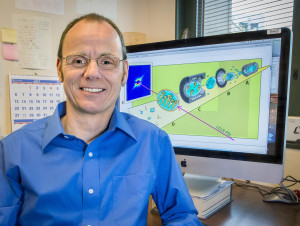Scientists have, for the first time, characterized so-called quantum vortices that swirl within tiny droplets of liquid helium. The research, led by scientists at the U.S. Department of Energy’s Lawrence Berkeley National Laboratory (Berkeley Lab), the University of Southern California, and SLAC National Accelerator Laboratory, confirms that helium nanodroplets are in fact the smallest possible superfluidic objects and opens new avenues for studying quantum rotation.
“The observation of quantum vortices is one of the most clear and unique demonstrations of the quantum properties of these microscopic objects,” says Oliver Gessner, senior scientist in the Chemical Sciences Division at Berkeley Lab. Gessner and colleagues, Andrey Vilesov of the University of Southern California and Christoph Bostedt of SLAC National Accelerator Laboratory at Stanford, led the multi-facility and multi-university team that published the work this week in Science.

Illustration of analysis of superfluid helium nanodroplets. Droplets are emitted via a cooled nozzle (upper right) and probed with x-ray from the free-electron laser. The multicolored pattern (upper left) represents a diffraction pattern that reveals the shape of a droplet and the presence of quantum vortices such as those represented in the turquoise circle with swirls (bottom center). Credit: Felix P. Sturm and Daniel S. Slaughter, Berkeley Lab.
The finding could have implications for other liquid or gas systems that contain vortices, says USC’s Vilesov. “The quest for quantum vortices in superfluid droplets has stretched for decades,” he says. “But this is the first time they have been seen in superfluid droplets.”
Superfluid helium has long captured scientist’s imagination since its discovery in the 1930s. Unlike normal fluids, superfluids have no viscosity, a feature that leads to strange and sometimes unexpected properties such as crawling up the walls of containers or dripping through barriers that contained the liquid before it transitioned to a superfluid.
Helium superfluidity can be achieved when helium is cooled to near absolute zero (zero kelvin or about -460 degrees F). At this temperature, the atoms within the liquid no longer vibrate with heat energy and instead settle into a calm state in which all atoms act together in unison, as if they were a single particle.
For decades, researchers have known that when superfluid helium is rotated–in a little spinning bucket, say–the rotation produces quantum vortices, swirls that are regularly spaced throughout the liquid. But the question remained whether anyone could see this behavior in an isolated, nanoscale droplet. If the swirls were there, it would confirm that helium nanodroplets, which can range in size from tens of nanometers to microns, are indeed superfluid throughout and that the motion of the entire liquid drop is that of a single quantum object rather than a mixture of independent particles.
But measuring liquid flow in helium nanodroplets has proven to be a serious challenge. “The way these droplets are made is by passing helium through a tiny nozzle that is cryogenically cooled down to below 10 Kelvin,” says Gessner. “Then, the nanoscale droplets shoot through a vacuum chamber at almost 200 meters-per-second. They live once for a few milliseconds while traversing the experimental chamber and then they’re gone. How do you show that these objects, which are all different from one another, have quantum vortices inside?”
The researchers turned to a facility at SLAC called the Linac Coherent Light Source (LCLS), a DOE Office of Science user facility that is the world’s first x-ray free-electron laser. This laser produces very short light pulses, lasting just a ten-trillionth of a second, which contain a huge number of high-energy photons. These intense x-ray pulses can effectively take snapshots of single, ultra-fast, ultra-small objects and phenomena.
“With the new x-ray free electron laser, we can now image phenomenon and look at processes far beyond what we could imagine just a decade ago,” says Bostedt of SLAC. “Looking at the droplets gave us a beautiful glimpse into the quantum world. It really opens the door to fascinating sciences.”
In the experiment, the researchers blasted a stream of helium nanodroplets across the x-ray laser beam inside a vacuum chamber; a detector caught the pattern that formed when the x-ray light diffracted off the drops.
The diffraction patterns immediately revealed that the shape of many droplets were not spheres, as was previously assumed. Instead, they were oblate. Just as the Earth’s rotation causes it to bulge at the equator, so too do rotating nanodroplets expand around the middle and flatten at the top and bottom.
But the vortices themselves are invisible to x-ray diffraction, so the researchers used a trick of adding xenon atoms to the droplets. The xenon atoms get pulled into the vortices and cluster together.
“It’s similar to pulling the plug in a bathtub and watching the kids’ toys gather in the vortex,” says Gessner. The xenon atoms diffract x-ray light much stronger than the surrounding helium, making the regular arrays of vortices inside the droplet visible. In this way, the researchers confirmed that vortices in nanodroplets behave as those found in larger amounts of rotating superfluid helium.
Armed with this new information, the researchers were able to determine the rotational speed of the nanodroplets. They were surprised to find that the nanodroplets spin up to 100,000 times faster than any other superfluid helium sample ever studied in a laboratory.
Moreover, while normal liquid drops will change shape as they spin faster and faster–to resemble a peanut or multi-lobed globule, for instance–the researchers saw no evidence of such shapeshifting in the helium nanodroplets. “Essentially, we’re exploring a new regime of quantum rotation with this matter,” Gessner says.
“It’s a new kind of matter in a sense because it is a self-contained isolated superfluid,” he adds. “It’s just all by itself, held together by its own surface tension. It’s pretty perfect to study these systems if one wants to understand superfluidity and isolate it as much as possible.”
This research was supported by the DOE Office of Science, Office of Basic Energy Sciences, Chemical Sciences, Geosciences and Biosciences Division as well as the National Science Foundation.
Additional Information
For more about Oliver Gessner go here.
For more about Andrey Vilesov go here.
For more about Christoph Bostedt and the LCLS go here.
For more about Berkeley Lab’s Chemical Sciences Division go here.
###
Lawrence Berkeley National Laboratory addresses the world’s most urgent scientific challenges by advancing sustainable energy, protecting human health, creating new materials, and revealing the origin and fate of the universe. Founded in 1931, Berkeley Lab’s scientific expertise has been recognized with 13 Nobel prizes. The University of California manages Berkeley Lab for the U.S. Department of Energy’s Office of Science. For more, visit http://www.lbl.gov.
The DOE Office of Science is the single largest supporter of basic research in the physical sciences in the United States and is working to address some of the most pressing challenges of our time. For more information, please visit science.energy.gov.

